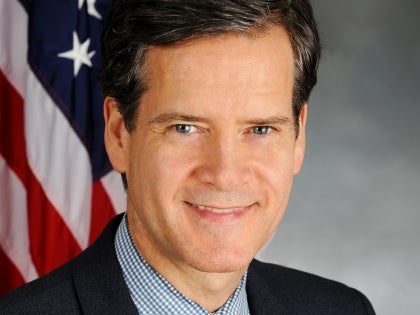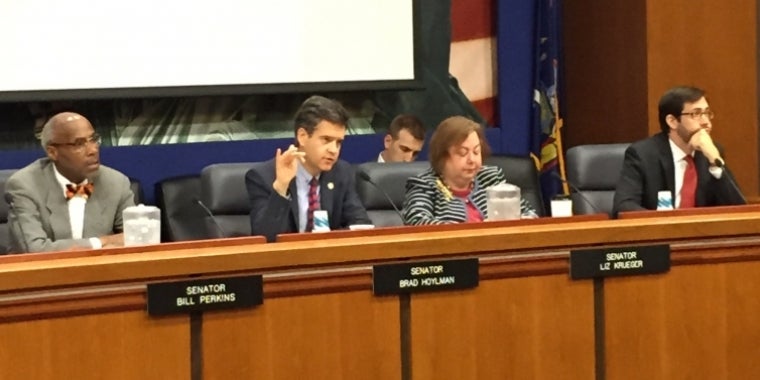
My Testimony to The New York State Department of Environmental Conservation Regarding Proposed Regulations for Solid Waste Management Facilities
Brad Hoylman
October 4, 2016
-
ISSUE:
- Fracking Waste

Thank you for the opportunity to submit comments to the New York State Department of Environmental Conservation (“DEC”) regarding the proposed regulations for Solid Waste Management Facilities (Part 360), the first comprehensive revision of these regulations since 1993. I appreciate the conversations DEC has had with me on this issue, and I look forward to working with the agency and my colleagues in government to ensure the safety and accountability of New York State’s solid waste management facilities.
As Ranking Member of the New York State Senate’s Environmental Conservation Committee, I urge DEC, through this regulatory process, to ban the discharge, disposal, or use within New York State of any oil or gas waste product created from the process of high-volume hydraulic fracturing (“hydrofracking”), including drill cuttings, flowback fluids, and production water and brine. Landfills should be prohibited from accepting hydrofracking waste products, the practice of spreading drilling and production waste products on roadways as a deicing agent or for any other purpose should be completely banned, and we should close the so-called “hazardous waste loophole” by eliminating the exemption that treats hydrofracking waste differently than other hazardous waste products.
As you are aware, Governor Andrew Cuomo announced a ban on hydrofracking in New York State in December 2014, following a two year review by the New York State Department of Health. Hydrofracking involves the high-pressure injection of millions of gallons of water and chemicals into rock to stimulate the production of oil and gas. The hydraulic fluid used in the hydrofracking process contains up to 300 chemicals, in categories that can include proppants, acids, breakers, bactericides/biocides, clay stabilizers, corrosion inhibitors, crosslinkers, friction reducers, gelling agents, iron controls, scale inhibitors, and surfactants.1 The chemical solution includes many known or suspected carcinogens like benzene and formaldehyde, as well as significant amounts of naturally occurring radioactive materials (NORMs) which break down to Radium-226 and Radium-228. The resulting liquid and solid waste products of hydrofracking contain all of the aforementioned residual chemicals.
If hydrofracking waste is not treated properly, these dangerous chemicals can enter our air, contaminate our water supply, and leach into the soil, causing significant public health and environmental risks. The chemicals in the waste product have been linked to diseases including lymphoma, bone cancer, and leukemia.2
The proposed revisions to Part 360 include several new regulations that would begin to limit the disposal and usage of hydrofracking waste in New York, and DEC should be commended for including them. However, given the serious public health and environmental concerns posed by this waste, we should take this opportunity to expand the regulations much further.
I am pleased, for example, that the proposed regulations include measures to curtail the use of hydrofracking waste on New York’s roadways (Section 360.12(f)). State documents obtained by the advocacy organization Riverkeeper show that since 2011, “road spreading of oil and natural gas production brine and natural gas storage brine has been approved for use in portions of at least 41 municipalities in nine New York counties, and for use on state roads in portions of at least 10 counties.”3 Spreading gas storage and production brine on roads exposes drivers, passengers, pedestrians, and wildlife to dangerous pollutants, while passing vehicles can cause the waste to become airborne and contaminate nearby surface waters, residential areas, and neighboring ecosystems.
The practice of spreading hydrofracking brine on roads to deice the surface is not currently prohibited by state law, and the proposed regulations would prohibit gas storage brine and production brine from wells located in the Marcellus Shale, as well as drilling fluids, flowback water, and production fluids from being spread on roads. However, these proposed regulations would allow road spreading approved on a caseby-case basis. I believe we should operate under a precautionary principle and ban the practice of road spreading any drilling or production waste for any purpose, regardless of the location of the originating well. Legislation I sponsor in the Senate (S.48) would accomplish that, but the issue could be more expediently addressed through this regulatory process.
I am also pleased that the proposed regulations would require landfills to install and operate fixed radiation detection units to monitor all incoming waste (Section 363- 8.1(a)(4)). This is a commonsense proposal to ensure that landfills accepting municipal solid wastes are monitoring and documenting any radioactive waste that enters the landfill. However, it would be beneficial for DEC to include standardized procedures 3 that landfill operators must follow to test for radiation, and provide clear guidance for when radioactive waste must be rejected by the landfill.
Missing from these proposed regulations is an explicit ban on the disposal of hydrofracking waste, including drill cuttings, flowback and production fluids, in landfills. In spite of New York’s ban on the practice of hydrofracking, it appears that waste from other states has been imported to New York to be dumped. According to a report by Environmental Advocates of New York (“EANY”), much of this imported waste originates from hydrofracking operations in Pennsylvania, a state that prohibited its wastewater treatment facilities from accepting such waste due to concerns about water contamination and the ability of treatment plants to properly handle it.
The EANY report found that from 2010 to 2014, the Pennsylvania Department of Environmental Protection sent over at least 26,000 barrels of liquid hydrofracking waste and 460,000 tons of solid hydrofracking waste to be treated in New York, where there is no such ban, 4 and at least seven landfills in New York State have accepted hydrofracking waste from Pennsylvania at some point since 2010. 5 While I acknowledge DEC’s contention that the Pennsylvania data is self-reported by oil and gas producers and may contain some inaccuracies, it seems clear that we can and should do more to ensure that this hazardous material does not end up in New York State landfills.
These proposed regulations also do not repeal the so-called “hazardous waste loophole” found in Section 371.1(e)(2)(v), which specifically exempts from the definition of hazardous waste “drilling fluids, produced waters, and other wastes associated with the exploration, development, or production of crude oil, natural gas or geothermal energy.” As a result hydrofracking waste is exempt from state laws and regulations pertaining to the generation, transportation, treatment, storage, and disposal of hazardous waste materials.
This exemption persists despite the fact that such hydrofracking byproducts often contain constituent chemicals that would, on their own, be subject to hazardous waste regulations. The science is clear that hydrofracking waste products are in fact hazardous – indeed, the hazards of hydrofracking waste were cited by the New York State Department of Health as part of the justification for the state ban on hydrofracking – and therefore the so-called “hazardous waste loophole” should be closed to treat them as such. I understand from discussions with DEC that future regulations to address this loophole may be forthcoming, and I look forward to working with the agency to achieve that.
Banning hydrofracking waste disposal and use has widespread local support in New York. According to Riverkeeper, at least 15 counties have banned hydrofracking waste from wastewater treatment plants, landfills, and roads, and last month New York City 4 passed legislation following suit.6 In December 2015, Manhattan Community Board 6 passed a resolution in support of a hydrofracking waste ban at the state and city levels.
I sponsor several bills at the state level that would curtail the import, disposal, and use of hydrofracking waste in New York, including S.45A to prohibit wastewater treatment facilities from accepting hydrofracking waste unless the facilities meet strict performance requirements, S.47 to prohibit the transportation of hydrofracking waste throughout the state, S.48 to prohibit the use of hydrofracking waste on highways, and S.340 to outright ban hydrofracking waste from wastewater treatment facilities and landfills. I am also a co-sponsor of S.884, which would close the “hazardous waste loophole.”
DEC can and should take this opportunity to address these critical issues without waiting for the Legislature to act by amending Part 360 to include a ban on the disposal or use of hydrofracking waste. New York must ensure that out-of-state hydrofracking waste products are not accepted at its landfills, completely ban the practice of using the waste products on its roads, and close the hazardous waste loophole in order to protect the state’s environment and public health.
Thank you for your consideration of my comments